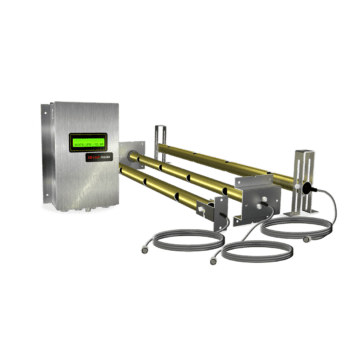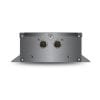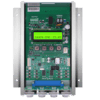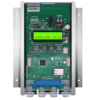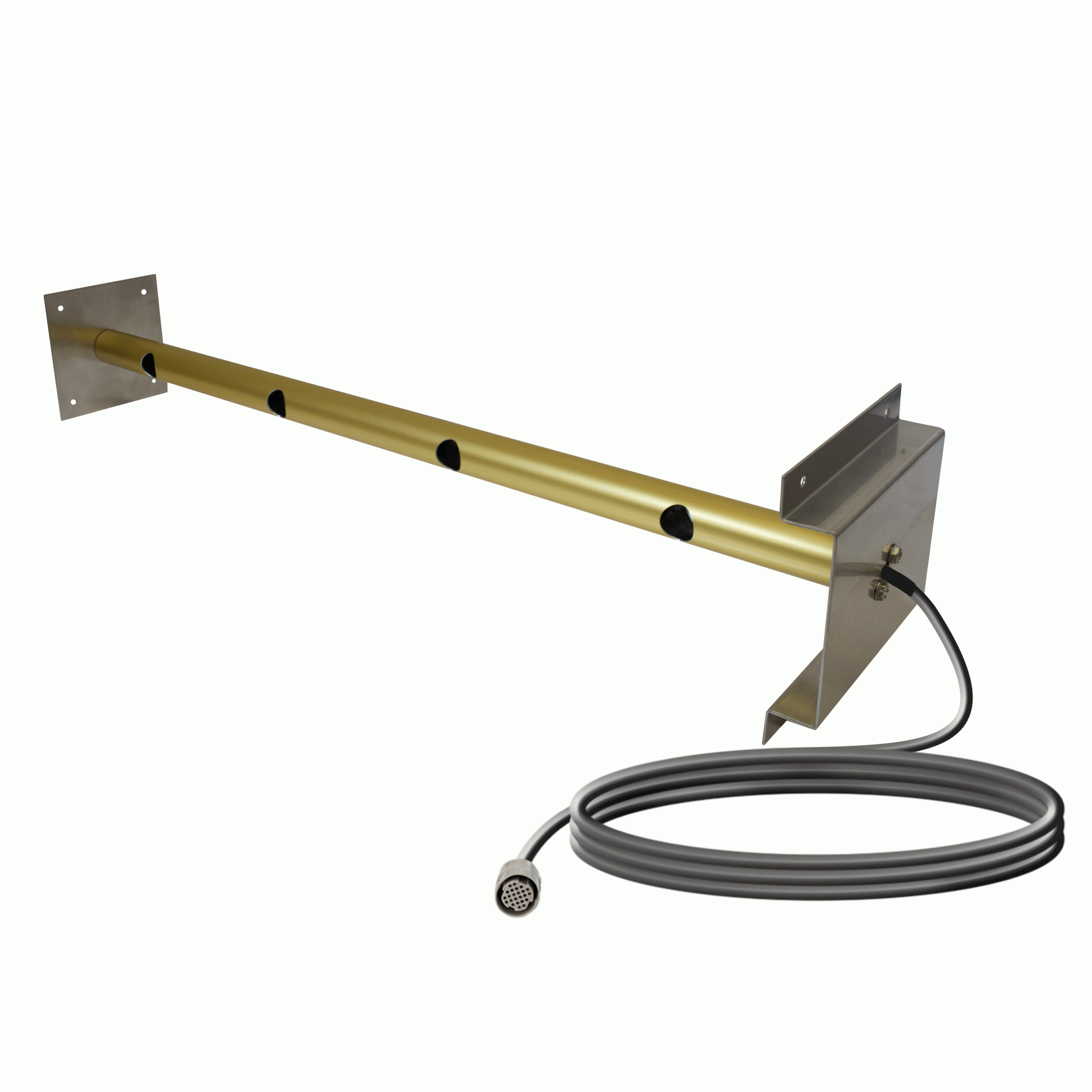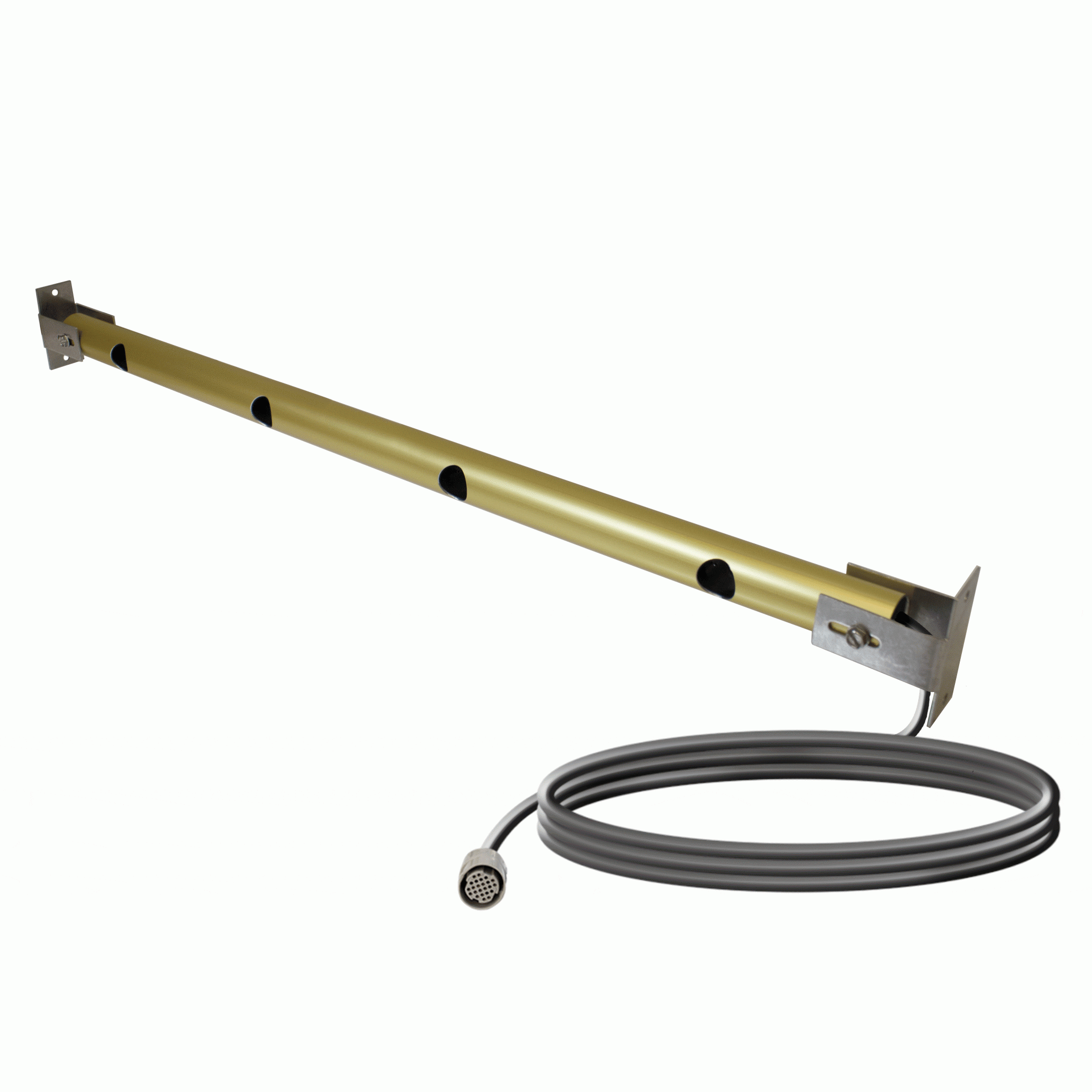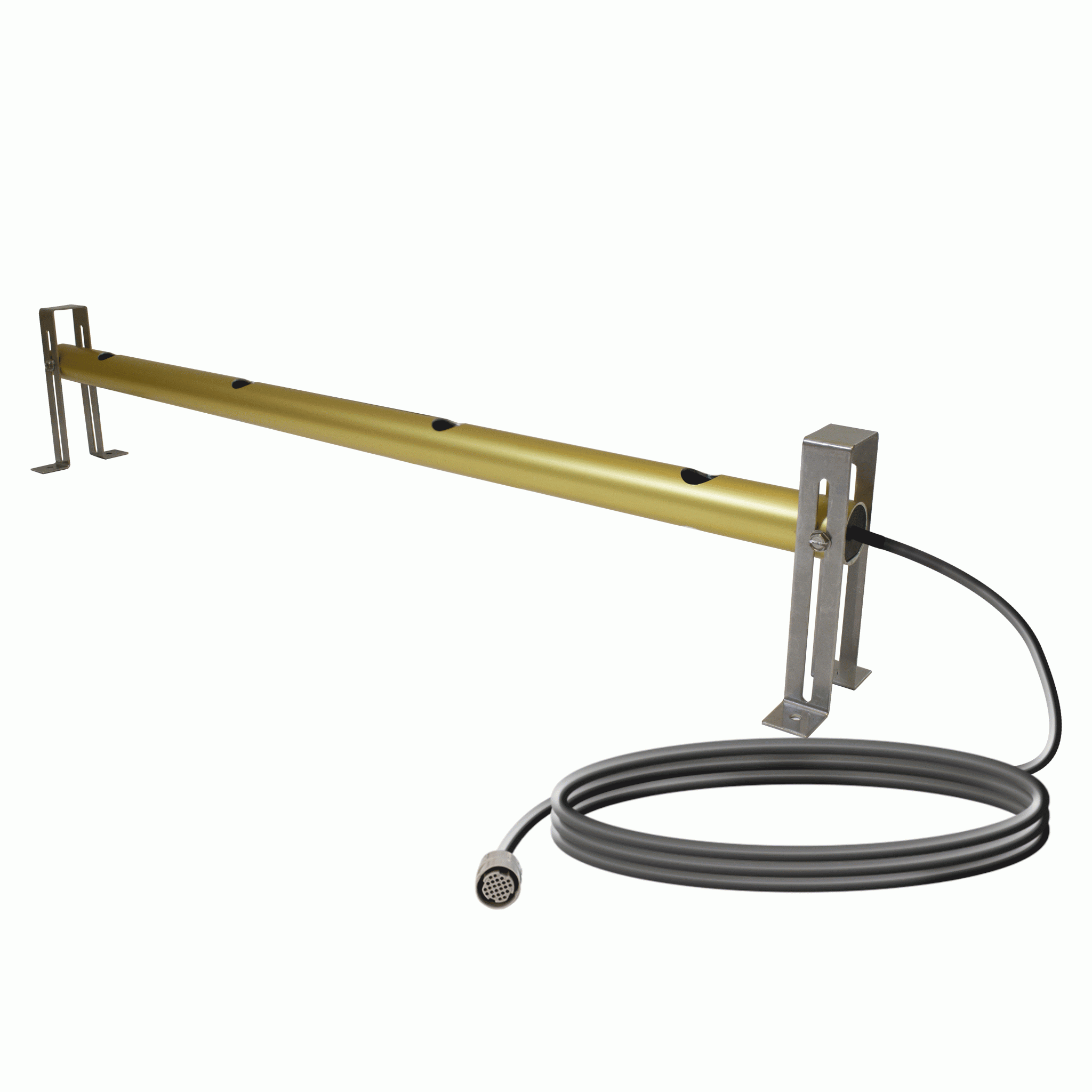The GTx116e‐P+ is EBTRON’s top‐of‐the‐line solution for accurate and repeatable measurement in ducts and plenums. Ideal for outdoor air delivery monitoring and airflow tracking applications. Temperature and alarm capability plus unsurpassed product features and connectivity options make this the best choice for today’s high performance buildings. Bluetooth® low energy technology interface.
Advantage IV
Gold Series
GTx116e-P+Airflow Measurement with Temperature and Alarm Capability
- Thermal Dispersion Airflow Technology
- Supports up to 16 Sensor Nodes
- NIST-traceable Calibration
- %-of-reading Airflow Accuracy
- Airflow and Status Alarms
- Temperature Output Capability
- Combination Analog/Network Models
- Three Mounting Styles
- Remote Transmitter with LCD Display
- 3-year Warranty
Typical Applications
- Outdoor Air Delivery Monitoring
- Differential Airflow Tracking
- Hospital Pressurization
- Laboratory Pressurization
- Air Change Verification & Monitoring
- System Performance Monitoring
Benefits
- Comply with ASHRAE Standards and Building Codes
- Demonstrate Code Compliance
- Satisfy LEED Prerequisites and Credits
- Provide Acceptable IAQ
- Save Energy
- Reduce Liability
- Improve Economizer Performance
Product Highlights
- Best Installed Accuracy
- Low Airflow Capability
- Volumetric or Mass Airflow Measurement
- Long-term Stability
- “Plug and Play” Operation
- Intuitive User Interface
- Waterproof Sensor Assembly
- FEP Plenum Rated Cables
General
Probe and Sensor Node Configurations (max.)
2 probes x 8 sensor nodes/probe
4 probes x 4 sensor nodes/probe
Installed Airflow Accuracy¹
Ducts/Plenum: ±3% of reading
Non-ducted OA Intakes: better than or equal to ±5% of reading
PC Sensor Density
Refer to the P+ sensor density table.
Sensor Node Averaging Method
Airflow: Independent, arithmetic average
Temperature: Independent, velocity weighted average
Listings and Compliance
UL: : UL-873 and CSA C22.2 No. 24
CE: Yes
UKCA: UK shipments only
BACnet International: BTL Listed (GTC116e and GTM116e transmitters)
FCC: This device complies with Part 15 of the FCC rules
RoHS: This device is RoHS2 compliant
Environmental Limits
Temperature:
Probes: -20 to 160 ºF [-28.9 to 71.1 ºC]
Transmitter: -20 to 120 ºF [-28.9 to 48.9 ºC]
Humidity: (non-condensing)
Probes: 0 to 100%
Transmitter: 5 to 95%
Individual Sensing Nodes
Sensing Node Sensors
Self-heated sensor: Precision, hermetically sealed, bead-in-glass thermistor probe
Temperature sensor: Precision, hermetically sealed, bead-in-glass thermistor probe
Sensing Node Housing
Material: Glass-filled Polypropylene (Kynar® with /SS option)
Sensor Potting Materials: Waterproof marine epoxy
Sensing Node Internal Wiring
Type: Kynar® coated copper
Airflow Measurement
Accuracy: ±2% of reading to NIST-traceable airflow standards (includes transmitter uncertainty)
Calibrated Range: 0 to 5,000 fpm [25.4 m/s]
Calibration Points: 16
Temperature Measurement
Accuracy: ±0.15⁰F [0.08 ⁰C] to NIST-traceable temperature standards (includes transmitter uncertainty)
Calibrated Range: -20 to 160 ⁰F [-28.9 to 71.1 ⁰C]
Calibrated Points: 3
Sensor Probe Assembly
Tube
Material: Gold anodized 6063 aluminum (316 stainless steel with /SS option)
Mounting Brackets
Material: 304 stainless steel
Mounting Options & Size Limit¹
Insertion : 6 to 191 in. [152.4 to 4851 mm]
Stand-off: 6 to 190 in. [152.4 to 4826 mm]
Internal: 8 to 194 in. [203.2 to 4928 mm]
Note: The /H option is only available on probes >18 in.[457.2 mm]
Probe to Transmitter Cables
Type: FEP jacket, plenum rated CMP/CL2P, UL/cUL listed, -67 to 302 ⁰F [-55 to 150 ⁰C], UV tolerant
Standard Lengths: 10, 15, 20, 25, 30, 40 and 50 ft. [3.1, 4.6, 6.1, 7.6, 9.1, 12.2, and 15.2 m]
Connecting Plug: 13/16” [20.63 mm] nominal diameter with gold-plated connector pins
Transmitter
Power Requirement:
24 VAC (22.8 to 26.4 under load) @20V-A max.
Connector Receptacle Pins and PCB Connections:
Gold-plated receptacle pins, PCB interconnects, PCB edge fingers, and test points
User Interface:
2 line x16-character backlit LCD display and 4 button interface
B.A.S. Connectivity Options
All Transmitter: Three field selectable (0-5/0-10 VDC or 4-20mA), scalable and isolated analog output signals (AO1=airflow, AO2=temperature or alarm, AO3=%RH, enthalpy or dew point). when / H option is provided
GTA116e Transmitter: No additional connectivity to B.A.S.
GTC116e Transmitter: One additional field selectable (BACnet MS/TP or Modbus RTU) and isolated RS-485 network connection -Individual sensor node airflow rates and temperatures are available via the network
GTM116e Transmitter: One additional isolated Ethernet
(simultaneously supported BACnet Ethernet or BACnet IP, Modbus TCP and TCP/IP) network connection – Individual sensor node airflow rates and temperatures are available via the network
GTF116e Transmitter: One additional isolated Lonworks Free Topology network connection
GTU116e Transmitter: One additional USB connection for thumb drive data-logging of sensor node airflow rates and temperatures
Airflow Alarm
Type: Low and/or high user defined setpoint alarm
Tolerance: User defined % of setpoint
Delay: User defined
Zero Disable: Alarm can be disabled when the airflow rate falls below the low limit cutoff value (unoccupied periods)
Reset Method: Manual or automatic
Visual Indication: Yes, LCD display
Analog Signal Indication: Yes, on AO2 assignment
System Status Alarm
Type: Sensor diagnostic system trouble indication
Visual Indication: Yes, LCD display
Analog Signal Indication: Yes, on AO2 assignment
EB-Link Bluetooth Interface for Android® and iPhone®:
Display real-time airflow, velocity-weighted temperature, humidity, enthalpy, dew point, individual sensor node airflow/temperature data, settings and diagnostics.
¹ Installed airflow accuracy allows for additional uncertainty that results from averaging a finite number of sensors in a contorted velocity profile created from up and downstream disturbances. The specified installed accuracy is based on the P+ sensor density rules for installations that meet or exceed EBTRON minimum placement requirements. P+ sensor density rules may not be available in certain duct sizes due to sensor placement limitations.
Related Documents
Type
Title
WP_Post Object
(
[ID] => 90011353
[post_author] => 464
[post_date] => 2021-03-12 12:15:38
[post_date_gmt] => 2021-03-12 17:15:38
[post_content] =>
[post_title] => Product Catalog
[post_excerpt] =>
[post_status] => publish
[comment_status] => closed
[ping_status] => closed
[post_password] =>
[post_name] => product-catalog
[to_ping] =>
[pinged] =>
[post_modified] => 2023-01-19 14:41:23
[post_modified_gmt] => 2023-01-19 19:41:23
[post_content_filtered] =>
[post_parent] => 0
[guid] => https://ebtron.com/?post_type=document&p=90011353
[menu_order] => 100
[post_type] => document
[post_mime_type] =>
[comment_count] => 0
[filter] => raw
[p2p_id] => 2531
[p2p_from] => 90011353
[p2p_to] => 90006167
[p2p_type] => documents_to_products
)
Array
(
[ID] => 90012954
[id] => 90012954
[title] => CondensedCatalog_compressed
[filename] => CondensedCatalog_compressed.pdf
[filesize] => 8956368
[url] => https://ebtron-dev.xyz/wp-content/uploads/CondensedCatalog_compressed.pdf
[link] => https://ebtron-dev.xyz/document/product-catalog/condensedcatalog_compressed/
[alt] =>
[author] => 464
[description] =>
[caption] =>
[name] => condensedcatalog_compressed
[status] => inherit
[uploaded_to] => 90011353
[date] => 2023-05-19 15:48:30
[modified] => 2023-05-19 15:51:13
[menu_order] => 0
[mime_type] => application/pdf
[type] => application
[subtype] => pdf
[icon] => https://ebtron-dev.xyz/wp-includes/images/media/document.png
)
Product Catalog
WP_Post Object
(
[ID] => 90011360
[post_author] => 464
[post_date] => 2021-03-12 14:36:31
[post_date_gmt] => 2021-03-12 19:36:31
[post_content] =>
[post_title] => AMD Model Comparisons
[post_excerpt] =>
[post_status] => publish
[comment_status] => closed
[ping_status] => closed
[post_password] =>
[post_name] => amd-model-comparisons
[to_ping] =>
[pinged] =>
[post_modified] => 2023-01-19 15:49:28
[post_modified_gmt] => 2023-01-19 20:49:28
[post_content_filtered] =>
[post_parent] => 0
[guid] => https://ebtron.com/?post_type=document&p=90011360
[menu_order] => 100
[post_type] => document
[post_mime_type] =>
[comment_count] => 0
[filter] => raw
[p2p_id] => 2542
[p2p_from] => 90011360
[p2p_to] => 90006167
[p2p_type] => documents_to_products
)
Array
(
[ID] => 90011359
[id] => 90011359
[title] => ProductComparison
[filename] => ProductComparison.pdf
[filesize] => 102839
[url] => https://ebtron-dev.xyz/wp-content/uploads/ProductComparison.pdf
[link] => https://ebtron-dev.xyz/document/amd-model-comparisons/productcomparison/
[alt] =>
[author] => 464
[description] =>
[caption] =>
[name] => productcomparison
[status] => inherit
[uploaded_to] => 90011360
[date] => 2023-01-18 20:38:56
[modified] => 2023-01-18 20:40:39
[menu_order] => 0
[mime_type] => application/pdf
[type] => application
[subtype] => pdf
[icon] => https://ebtron-dev.xyz/wp-includes/images/media/document.png
)
Model Comparisons
WP_Post Object
(
[ID] => 90011392
[post_author] => 464
[post_date] => 2021-03-15 11:36:14
[post_date_gmt] => 2021-03-15 15:36:14
[post_content] =>
[post_title] => GTx116e-P+ Overview
[post_excerpt] =>
[post_status] => publish
[comment_status] => closed
[ping_status] => closed
[post_password] =>
[post_name] => gtx116e-p-overview
[to_ping] =>
[pinged] =>
[post_modified] => 2021-03-29 17:34:19
[post_modified_gmt] => 2021-03-29 21:34:19
[post_content_filtered] =>
[post_parent] => 0
[guid] => https://ebtron.com/?post_type=document&p=90011392
[menu_order] => 100
[post_type] => document
[post_mime_type] =>
[comment_count] => 0
[filter] => raw
[p2p_id] => 2525
[p2p_from] => 90011392
[p2p_to] => 90006167
[p2p_type] => documents_to_products
)
Array
(
[ID] => 90011363
[id] => 90011363
[title] => GTx116e-P+_Overview
[filename] => GTx116e-P_Overview.pdf
[filesize] => 489379
[url] => https://ebtron-dev.xyz/wp-content/uploads/GTx116e-P_Overview.pdf
[link] => https://ebtron-dev.xyz/document/gtx116e-p-overview/gtx116e-p_overview/
[alt] =>
[author] => 464
[description] =>
[caption] =>
[name] => gtx116e-p_overview
[status] => inherit
[uploaded_to] => 90011392
[date] => 2023-01-18 20:46:07
[modified] => 2023-01-18 20:47:23
[menu_order] => 0
[mime_type] => application/pdf
[type] => application
[subtype] => pdf
[icon] => https://ebtron-dev.xyz/wp-includes/images/media/document.png
)
Data Sheets
WP_Post Object
(
[ID] => 90011405
[post_author] => 464
[post_date] => 2021-03-16 12:36:38
[post_date_gmt] => 2021-03-16 16:36:38
[post_content] =>
[post_title] => GTx116e-P+ Sensor Density
[post_excerpt] =>
[post_status] => publish
[comment_status] => closed
[ping_status] => closed
[post_password] =>
[post_name] => gtx116e-p-sensor-density
[to_ping] =>
[pinged] =>
[post_modified] => 2021-03-29 17:33:18
[post_modified_gmt] => 2021-03-29 21:33:18
[post_content_filtered] =>
[post_parent] => 0
[guid] => https://ebtron.com/?post_type=document&p=90011405
[menu_order] => 200
[post_type] => document
[post_mime_type] =>
[comment_count] => 0
[filter] => raw
[p2p_id] => 2524
[p2p_from] => 90011405
[p2p_to] => 90006167
[p2p_type] => documents_to_products
)
Array
(
[ID] => 90011364
[id] => 90011364
[title] => GTx116e-P+_SensorDensity
[filename] => GTx116e-P_SensorDensity.pdf
[filesize] => 746507
[url] => https://ebtron-dev.xyz/wp-content/uploads/GTx116e-P_SensorDensity.pdf
[link] => https://ebtron-dev.xyz/document/gtx116e-p-sensor-density/gtx116e-p_sensordensity/
[alt] =>
[author] => 464
[description] =>
[caption] =>
[name] => gtx116e-p_sensordensity
[status] => inherit
[uploaded_to] => 90011405
[date] => 2021-03-12 20:01:32
[modified] => 2021-03-16 16:36:29
[menu_order] => 0
[mime_type] => application/pdf
[type] => application
[subtype] => pdf
[icon] => https://ebtron-dev.xyz/wp-includes/images/media/document.png
)
Sensor Density Table
WP_Post Object
(
[ID] => 90016324
[post_author] => 464
[post_date] => 2022-12-02 11:32:30
[post_date_gmt] => 2022-12-02 16:32:30
[post_content] =>
[post_title] => EBTRON Placement Tool
[post_excerpt] =>
[post_status] => publish
[comment_status] => closed
[ping_status] => closed
[post_password] =>
[post_name] => ebtron-placement-tool
[to_ping] =>
[pinged] =>
[post_modified] => 2023-01-26 15:43:18
[post_modified_gmt] => 2023-01-26 20:43:18
[post_content_filtered] =>
[post_parent] => 0
[guid] => https://ebtron.com/?post_type=document&p=90016324
[menu_order] => 100
[post_type] => document
[post_mime_type] =>
[comment_count] => 0
[filter] => raw
[p2p_id] => 2783
[p2p_from] => 90016324
[p2p_to] => 90006167
[p2p_type] => documents_to_products
)
Array
(
[ID] => 90016323
[id] => 90016323
[title] => EBTRON_PlacementTool
[filename] => EBTRON_PlacementTool.xlsm
[filesize] => 119571
[url] => https://ebtron-dev.xyz/wp-content/uploads/EBTRON_PlacementTool.xlsm
[link] => https://ebtron-dev.xyz/document/ebtron-placement-tool/ebtron_placementtool/
[alt] =>
[author] => 464
[description] =>
[caption] =>
[name] => ebtron_placementtool
[status] => inherit
[uploaded_to] => 90016324
[date] => 2022-12-02 16:23:43
[modified] => 2022-12-02 16:32:30
[menu_order] => 0
[mime_type] => application/vnd.ms-excel.sheet.macroEnabled.12
[type] => application
[subtype] => vnd.ms-excel.sheet.macroEnabled.12
[icon] => https://ebtron-dev.xyz/wp-includes/images/media/spreadsheet.png
)
Tools
Array
(
[0] => Array
(
[file_contents] =>
[application_and_notes] => This file will require macros to be enabled/unblocked before running.
[supported_os] =>
)
)
Application and Notes
This file will require macros to be enabled/unblocked before running.
WP_Post Object
(
[ID] => 90012947
[post_author] => 464
[post_date] => 2021-09-01 12:03:54
[post_date_gmt] => 2021-09-01 16:03:54
[post_content] =>
[post_title] => A4/EF2 O&M Manual
[post_excerpt] =>
[post_status] => publish
[comment_status] => closed
[ping_status] => closed
[post_password] =>
[post_name] => a4-ef2-om-manual
[to_ping] =>
[pinged] =>
[post_modified] => 2023-01-12 17:17:28
[post_modified_gmt] => 2023-01-12 22:17:28
[post_content_filtered] =>
[post_parent] => 0
[guid] => https://ebtron.com/?post_type=document&p=90012947
[menu_order] => 100
[post_type] => document
[post_mime_type] =>
[comment_count] => 0
[filter] => raw
[p2p_id] => 2625
[p2p_from] => 90012947
[p2p_to] => 90006167
[p2p_type] => documents_to_products
)
Array
(
[ID] => 90012946
[id] => 90012946
[title] => A4_EF2_OM_Manual-compressed
[filename] => A4_EF2_OM_Manual-compressed.pdf
[filesize] => 14442377
[url] => https://ebtron-dev.xyz/wp-content/uploads/A4_EF2_OM_Manual-compressed.pdf
[link] => https://ebtron-dev.xyz/document/a4-ef2-om-manual/a4_ef2_om_manual-compressed/
[alt] =>
[author] => 464
[description] =>
[caption] =>
[name] => a4_ef2_om_manual-compressed
[status] => inherit
[uploaded_to] => 90012947
[date] => 2023-01-12 21:37:46
[modified] => 2023-01-12 21:38:02
[menu_order] => 0
[mime_type] => application/pdf
[type] => application
[subtype] => pdf
[icon] => https://ebtron-dev.xyz/wp-includes/images/media/document.png
)
O&M Manual
WP_Post Object
(
[ID] => 90016453
[post_author] => 464
[post_date] => 2023-01-13 11:25:24
[post_date_gmt] => 2023-01-13 16:25:24
[post_content] =>
[post_title] => Duct & Plenum Probe Placement Guide
[post_excerpt] =>
[post_status] => publish
[comment_status] => closed
[ping_status] => closed
[post_password] =>
[post_name] => duct-plenum-probe-placement-guide
[to_ping] =>
[pinged] =>
[post_modified] => 2023-01-13 12:28:49
[post_modified_gmt] => 2023-01-13 17:28:49
[post_content_filtered] =>
[post_parent] => 0
[guid] => https://ebtron.com/?post_type=document&p=90016453
[menu_order] => 100
[post_type] => document
[post_mime_type] =>
[comment_count] => 0
[filter] => raw
[p2p_id] => 2807
[p2p_from] => 90016453
[p2p_to] => 90006167
[p2p_type] => documents_to_products
)
Array
(
[ID] => 90016452
[id] => 90016452
[title] => Placement_Duct_Plenum_Probe
[filename] => Placement_Duct_Plenum_Probe.pdf
[filesize] => 781163
[url] => https://ebtron-dev.xyz/wp-content/uploads/Placement_Duct_Plenum_Probe.pdf
[link] => https://ebtron-dev.xyz/document/duct-plenum-probe-placement-guide/placement_duct_plenum_probe/
[alt] =>
[author] => 464
[description] =>
[caption] =>
[name] => placement_duct_plenum_probe
[status] => inherit
[uploaded_to] => 90016453
[date] => 2023-01-13 16:20:48
[modified] => 2023-01-13 16:25:24
[menu_order] => 0
[mime_type] => application/pdf
[type] => application
[subtype] => pdf
[icon] => https://ebtron-dev.xyz/wp-includes/images/media/document.png
)
Placement Guides
WP_Post Object
(
[ID] => 90011284
[post_author] => 464
[post_date] => 2021-03-09 15:27:11
[post_date_gmt] => 2021-03-09 20:27:11
[post_content] =>
[post_title] => -P Rectangular Insertion Installation Guide
[post_excerpt] =>
[post_status] => publish
[comment_status] => closed
[ping_status] => closed
[post_password] =>
[post_name] => p-rectangular-insertion-installation-guide
[to_ping] =>
[pinged] =>
[post_modified] => 2021-03-29 18:00:27
[post_modified_gmt] => 2021-03-29 22:00:27
[post_content_filtered] =>
[post_parent] => 0
[guid] => https://ebtron.com/?post_type=document&p=90011284
[menu_order] => 100
[post_type] => document
[post_mime_type] =>
[comment_count] => 0
[filter] => raw
[p2p_id] => 2543
[p2p_from] => 90011284
[p2p_to] => 90006167
[p2p_type] => documents_to_products
)
Array
(
[ID] => 90011281
[id] => 90011281
[title] => Installation_-P_Rect_Insertion
[filename] => Installation_-P_Rect_Insertion.pdf
[filesize] => 313010
[url] => https://ebtron-dev.xyz/wp-content/uploads/Installation_-P_Rect_Insertion.pdf
[link] => https://ebtron-dev.xyz/document/p-rectangular-insertion-installation-guide/installation_-p_rect_insertion/
[alt] =>
[author] => 464
[description] =>
[caption] =>
[name] => installation_-p_rect_insertion
[status] => inherit
[uploaded_to] => 90011284
[date] => 2021-11-30 16:32:25
[modified] => 2021-11-30 16:33:33
[menu_order] => 0
[mime_type] => application/pdf
[type] => application
[subtype] => pdf
[icon] => https://ebtron-dev.xyz/wp-includes/images/media/document.png
)
Sensor Probe Installation
WP_Post Object
(
[ID] => 90011286
[post_author] => 464
[post_date] => 2021-03-09 15:54:34
[post_date_gmt] => 2021-03-09 20:54:34
[post_content] =>
[post_title] => -P Rectangular Internal Installation Guide
[post_excerpt] =>
[post_status] => publish
[comment_status] => closed
[ping_status] => closed
[post_password] =>
[post_name] => p-rectangular-internal-installation-guide
[to_ping] =>
[pinged] =>
[post_modified] => 2021-07-28 16:13:31
[post_modified_gmt] => 2021-07-28 20:13:31
[post_content_filtered] =>
[post_parent] => 0
[guid] => https://ebtron.com/?post_type=document&p=90011286
[menu_order] => 200
[post_type] => document
[post_mime_type] =>
[comment_count] => 0
[filter] => raw
[p2p_id] => 2545
[p2p_from] => 90011286
[p2p_to] => 90006167
[p2p_type] => documents_to_products
)
Array
(
[ID] => 90011278
[id] => 90011278
[title] => Installation_-P_Rect_Internal
[filename] => Installation_-P_Rect_Internal.pdf
[filesize] => 324186
[url] => https://ebtron-dev.xyz/wp-content/uploads/Installation_-P_Rect_Internal.pdf
[link] => https://ebtron-dev.xyz/document/p-rectangular-internal-installation-guide/installation_-p_rect_internal/
[alt] =>
[author] => 464
[description] =>
[caption] =>
[name] => installation_-p_rect_internal
[status] => inherit
[uploaded_to] => 90011286
[date] => 2021-11-30 16:30:00
[modified] => 2021-11-30 16:30:14
[menu_order] => 0
[mime_type] => application/pdf
[type] => application
[subtype] => pdf
[icon] => https://ebtron-dev.xyz/wp-includes/images/media/document.png
)
Sensor Probe Installation
WP_Post Object
(
[ID] => 90011288
[post_author] => 464
[post_date] => 2021-03-09 16:00:58
[post_date_gmt] => 2021-03-09 21:00:58
[post_content] =>
[post_title] => -P Rectangular Standoff Installation Guide
[post_excerpt] =>
[post_status] => publish
[comment_status] => closed
[ping_status] => closed
[post_password] =>
[post_name] => p-rectangular-standoff-installation-guide
[to_ping] =>
[pinged] =>
[post_modified] => 2021-03-29 18:01:24
[post_modified_gmt] => 2021-03-29 22:01:24
[post_content_filtered] =>
[post_parent] => 0
[guid] => https://ebtron.com/?post_type=document&p=90011288
[menu_order] => 300
[post_type] => document
[post_mime_type] =>
[comment_count] => 0
[filter] => raw
[p2p_id] => 2544
[p2p_from] => 90011288
[p2p_to] => 90006167
[p2p_type] => documents_to_products
)
Array
(
[ID] => 90011279
[id] => 90011279
[title] => Installation_-P_Rect_Standoff
[filename] => Installation_-P_Rect_Standoff.pdf
[filesize] => 300310
[url] => https://ebtron-dev.xyz/wp-content/uploads/Installation_-P_Rect_Standoff.pdf
[link] => https://ebtron-dev.xyz/document/p-rectangular-standoff-installation-guide/installation_-p_rect_standoff/
[alt] =>
[author] => 464
[description] =>
[caption] =>
[name] => installation_-p_rect_standoff
[status] => inherit
[uploaded_to] => 90011288
[date] => 2021-11-30 16:27:32
[modified] => 2021-11-30 16:27:50
[menu_order] => 0
[mime_type] => application/pdf
[type] => application
[subtype] => pdf
[icon] => https://ebtron-dev.xyz/wp-includes/images/media/document.png
)
Sensor Probe Installation
WP_Post Object
(
[ID] => 90011289
[post_author] => 464
[post_date] => 2021-03-09 16:12:12
[post_date_gmt] => 2021-03-09 21:12:12
[post_content] =>
[post_title] => -P Round Insertion Installation Guide
[post_excerpt] =>
[post_status] => publish
[comment_status] => closed
[ping_status] => closed
[post_password] =>
[post_name] => p-round-insertion-installation-guide
[to_ping] =>
[pinged] =>
[post_modified] => 2021-03-29 18:02:47
[post_modified_gmt] => 2021-03-29 22:02:47
[post_content_filtered] =>
[post_parent] => 0
[guid] => https://ebtron.com/?post_type=document&p=90011289
[menu_order] => 400
[post_type] => document
[post_mime_type] =>
[comment_count] => 0
[filter] => raw
[p2p_id] => 2546
[p2p_from] => 90011289
[p2p_to] => 90006167
[p2p_type] => documents_to_products
)
Array
(
[ID] => 90011276
[id] => 90011276
[title] => Installation_-P_Rnd_Insertion
[filename] => Installation_-P_Rnd_Insertion.pdf
[filesize] => 282083
[url] => https://ebtron-dev.xyz/wp-content/uploads/Installation_-P_Rnd_Insertion.pdf
[link] => https://ebtron-dev.xyz/document/p-round-insertion-installation-guide/installation_-p_rnd_insertion/
[alt] =>
[author] => 464
[description] =>
[caption] =>
[name] => installation_-p_rnd_insertion
[status] => inherit
[uploaded_to] => 90011289
[date] => 2021-11-30 16:40:59
[modified] => 2021-11-30 16:41:43
[menu_order] => 0
[mime_type] => application/pdf
[type] => application
[subtype] => pdf
[icon] => https://ebtron-dev.xyz/wp-includes/images/media/document.png
)
Sensor Probe Installation
WP_Post Object
(
[ID] => 90011291
[post_author] => 464
[post_date] => 2021-03-09 16:33:33
[post_date_gmt] => 2021-03-09 21:33:33
[post_content] =>
[post_title] => -P Oval Type A Insertion Installation Guide
[post_excerpt] =>
[post_status] => publish
[comment_status] => closed
[ping_status] => closed
[post_password] =>
[post_name] => p-oval-type-a-insertion-installation-guide
[to_ping] =>
[pinged] =>
[post_modified] => 2021-03-29 18:05:07
[post_modified_gmt] => 2021-03-29 22:05:07
[post_content_filtered] =>
[post_parent] => 0
[guid] => https://ebtron.com/?post_type=document&p=90011291
[menu_order] => 500
[post_type] => document
[post_mime_type] =>
[comment_count] => 0
[filter] => raw
[p2p_id] => 2549
[p2p_from] => 90011291
[p2p_to] => 90006167
[p2p_type] => documents_to_products
)
Array
(
[ID] => 90011275
[id] => 90011275
[title] => Installation_-P_Oval_TypeA_Insertion
[filename] => Installation_-P_Oval_TypeA_Insertion.pdf
[filesize] => 247163
[url] => https://ebtron-dev.xyz/wp-content/uploads/Installation_-P_Oval_TypeA_Insertion.pdf
[link] => https://ebtron-dev.xyz/document/p-oval-type-a-insertion-installation-guide/installation_-p_oval_typea_insertion/
[alt] =>
[author] => 464
[description] =>
[caption] =>
[name] => installation_-p_oval_typea_insertion
[status] => inherit
[uploaded_to] => 90011291
[date] => 2022-03-01 18:16:15
[modified] => 2022-03-01 18:17:10
[menu_order] => 0
[mime_type] => application/pdf
[type] => application
[subtype] => pdf
[icon] => https://ebtron-dev.xyz/wp-includes/images/media/document.png
)
Sensor Probe Installation
WP_Post Object
(
[ID] => 90011292
[post_author] => 464
[post_date] => 2021-03-09 16:38:21
[post_date_gmt] => 2021-03-09 21:38:21
[post_content] =>
[post_title] => -P Oval Type B Insertion Installation Guide
[post_excerpt] =>
[post_status] => publish
[comment_status] => closed
[ping_status] => closed
[post_password] =>
[post_name] => p-oval-type-b-insertion-installation-guide
[to_ping] =>
[pinged] =>
[post_modified] => 2021-03-29 18:04:12
[post_modified_gmt] => 2021-03-29 22:04:12
[post_content_filtered] =>
[post_parent] => 0
[guid] => https://ebtron.com/?post_type=document&p=90011292
[menu_order] => 600
[post_type] => document
[post_mime_type] =>
[comment_count] => 0
[filter] => raw
[p2p_id] => 2548
[p2p_from] => 90011292
[p2p_to] => 90006167
[p2p_type] => documents_to_products
)
Array
(
[ID] => 90011280
[id] => 90011280
[title] => Installation_-P_Oval_TypeB_Insertion
[filename] => Installation_-P_Oval_TypeB_Insertion.pdf
[filesize] => 278063
[url] => https://ebtron-dev.xyz/wp-content/uploads/Installation_-P_Oval_TypeB_Insertion.pdf
[link] => https://ebtron-dev.xyz/document/p-oval-type-b-insertion-installation-guide/installation_-p_oval_typeb_insertion/
[alt] =>
[author] => 464
[description] =>
[caption] =>
[name] => installation_-p_oval_typeb_insertion
[status] => inherit
[uploaded_to] => 90011292
[date] => 2022-03-01 18:18:30
[modified] => 2022-03-01 18:21:15
[menu_order] => 0
[mime_type] => application/pdf
[type] => application
[subtype] => pdf
[icon] => https://ebtron-dev.xyz/wp-includes/images/media/document.png
)
Sensor Probe Installation
WP_Post Object
(
[ID] => 90011293
[post_author] => 464
[post_date] => 2021-03-09 16:42:24
[post_date_gmt] => 2021-03-09 21:42:24
[post_content] =>
[post_title] => -P Oval Type C Insertion Installation Guide
[post_excerpt] =>
[post_status] => publish
[comment_status] => closed
[ping_status] => closed
[post_password] =>
[post_name] => p-oval-type-c-insertion-installation-guide
[to_ping] =>
[pinged] =>
[post_modified] => 2021-04-06 11:45:55
[post_modified_gmt] => 2021-04-06 15:45:55
[post_content_filtered] =>
[post_parent] => 0
[guid] => https://ebtron.com/?post_type=document&p=90011293
[menu_order] => 700
[post_type] => document
[post_mime_type] =>
[comment_count] => 0
[filter] => raw
[p2p_id] => 2547
[p2p_from] => 90011293
[p2p_to] => 90006167
[p2p_type] => documents_to_products
)
Array
(
[ID] => 90011277
[id] => 90011277
[title] => Installation_-P_Oval_TypeC_Insertion
[filename] => Installation_-P_Oval_TypeC_Insertion.pdf
[filesize] => 269326
[url] => https://ebtron-dev.xyz/wp-content/uploads/Installation_-P_Oval_TypeC_Insertion.pdf
[link] => https://ebtron-dev.xyz/document/p-oval-type-c-insertion-installation-guide/installation_-p_oval_typec_insertion/
[alt] =>
[author] => 464
[description] =>
[caption] =>
[name] => installation_-p_oval_typec_insertion
[status] => inherit
[uploaded_to] => 90011293
[date] => 2022-03-01 18:22:04
[modified] => 2022-03-01 18:22:15
[menu_order] => 0
[mime_type] => application/pdf
[type] => application
[subtype] => pdf
[icon] => https://ebtron-dev.xyz/wp-includes/images/media/document.png
)
Sensor Probe Installation
WP_Post Object
(
[ID] => 90011145
[post_author] => 464
[post_date] => 2021-03-08 10:22:23
[post_date_gmt] => 2021-03-08 15:22:23
[post_content] =>
[post_title] => GTA116e-P Wiring Guide
[post_excerpt] =>
[post_status] => publish
[comment_status] => closed
[ping_status] => closed
[post_password] =>
[post_name] => gta116e-p-wiring-guide
[to_ping] =>
[pinged] =>
[post_modified] => 2021-03-30 10:06:42
[post_modified_gmt] => 2021-03-30 14:06:42
[post_content_filtered] =>
[post_parent] => 0
[guid] => https://ebtron.com/?post_type=document&p=90011145
[menu_order] => 100
[post_type] => document
[post_mime_type] =>
[comment_count] => 0
[filter] => raw
[p2p_id] => 2551
[p2p_from] => 90011145
[p2p_to] => 90006167
[p2p_type] => documents_to_products
)
Array
(
[ID] => 90011087
[id] => 90011087
[title] => Wiring_GTA116e-P
[filename] => Wiring_GTA116e-P.pdf
[filesize] => 262188
[url] => https://ebtron-dev.xyz/wp-content/uploads/Wiring_GTA116e-P.pdf
[link] => https://ebtron-dev.xyz/document/gta116e-p-wiring-guide/wiring_gta116e-p-2/
[alt] =>
[author] => 464
[description] =>
[caption] =>
[name] => wiring_gta116e-p-2
[status] => inherit
[uploaded_to] => 90011145
[date] => 2021-03-05 20:05:21
[modified] => 2021-03-08 14:59:33
[menu_order] => 0
[mime_type] => application/pdf
[type] => application
[subtype] => pdf
[icon] => https://ebtron-dev.xyz/wp-includes/images/media/document.png
)
Wiring Guides
WP_Post Object
(
[ID] => 90011152
[post_author] => 464
[post_date] => 2021-03-08 10:31:02
[post_date_gmt] => 2021-03-08 15:31:02
[post_content] =>
[post_title] => GTC116e-P Wiring Guide
[post_excerpt] =>
[post_status] => publish
[comment_status] => closed
[ping_status] => closed
[post_password] =>
[post_name] => gtc116e-p-wiring-guide
[to_ping] =>
[pinged] =>
[post_modified] => 2021-03-30 11:58:37
[post_modified_gmt] => 2021-03-30 15:58:37
[post_content_filtered] =>
[post_parent] => 0
[guid] => https://ebtron.com/?post_type=document&p=90011152
[menu_order] => 200
[post_type] => document
[post_mime_type] =>
[comment_count] => 0
[filter] => raw
[p2p_id] => 2553
[p2p_from] => 90011152
[p2p_to] => 90006167
[p2p_type] => documents_to_products
)
Array
(
[ID] => 90011088
[id] => 90011088
[title] => Wiring_GTC116e-P
[filename] => Wiring_GTC116e-P.pdf
[filesize] => 292699
[url] => https://ebtron-dev.xyz/wp-content/uploads/Wiring_GTC116e-P.pdf
[link] => https://ebtron-dev.xyz/document/gtc116e-p-wiring-guide/wiring_gtc116e-p-2/
[alt] =>
[author] => 464
[description] =>
[caption] =>
[name] => wiring_gtc116e-p-2
[status] => inherit
[uploaded_to] => 90011152
[date] => 2021-03-05 20:05:22
[modified] => 2021-03-08 15:29:14
[menu_order] => 0
[mime_type] => application/pdf
[type] => application
[subtype] => pdf
[icon] => https://ebtron-dev.xyz/wp-includes/images/media/document.png
)
Wiring Guides
WP_Post Object
(
[ID] => 90011153
[post_author] => 464
[post_date] => 2021-03-08 10:41:29
[post_date_gmt] => 2021-03-08 15:41:29
[post_content] =>
[post_title] => GTF116e-P Wiring Guide
[post_excerpt] =>
[post_status] => publish
[comment_status] => closed
[ping_status] => closed
[post_password] =>
[post_name] => gtf116e-p-wiring-guide
[to_ping] =>
[pinged] =>
[post_modified] => 2021-03-30 12:01:34
[post_modified_gmt] => 2021-03-30 16:01:34
[post_content_filtered] =>
[post_parent] => 0
[guid] => https://ebtron.com/?post_type=document&p=90011153
[menu_order] => 300
[post_type] => document
[post_mime_type] =>
[comment_count] => 0
[filter] => raw
[p2p_id] => 2555
[p2p_from] => 90011153
[p2p_to] => 90006167
[p2p_type] => documents_to_products
)
Array
(
[ID] => 90011091
[id] => 90011091
[title] => Wiring_GTF116e-P
[filename] => Wiring_GTF116e-P.pdf
[filesize] => 282045
[url] => https://ebtron-dev.xyz/wp-content/uploads/Wiring_GTF116e-P.pdf
[link] => https://ebtron-dev.xyz/document/gtf116e-p-wiring-guide/wiring_gtf116e-p-2/
[alt] =>
[author] => 464
[description] =>
[caption] =>
[name] => wiring_gtf116e-p-2
[status] => inherit
[uploaded_to] => 90011153
[date] => 2021-03-05 20:05:23
[modified] => 2021-03-08 15:38:22
[menu_order] => 0
[mime_type] => application/pdf
[type] => application
[subtype] => pdf
[icon] => https://ebtron-dev.xyz/wp-includes/images/media/document.png
)
Wiring Guides
WP_Post Object
(
[ID] => 90011155
[post_author] => 464
[post_date] => 2021-03-08 10:46:03
[post_date_gmt] => 2021-03-08 15:46:03
[post_content] =>
[post_title] => GTM116e-P Wiring Guide
[post_excerpt] =>
[post_status] => publish
[comment_status] => closed
[ping_status] => closed
[post_password] =>
[post_name] => gtm116e-p-wiring-guide
[to_ping] =>
[pinged] =>
[post_modified] => 2021-03-30 12:10:20
[post_modified_gmt] => 2021-03-30 16:10:20
[post_content_filtered] =>
[post_parent] => 0
[guid] => https://ebtron.com/?post_type=document&p=90011155
[menu_order] => 400
[post_type] => document
[post_mime_type] =>
[comment_count] => 0
[filter] => raw
[p2p_id] => 2559
[p2p_from] => 90011155
[p2p_to] => 90006167
[p2p_type] => documents_to_products
)
Array
(
[ID] => 90011089
[id] => 90011089
[title] => Wiring_GTM116e-P
[filename] => Wiring_GTM116e-P.pdf
[filesize] => 280566
[url] => https://ebtron-dev.xyz/wp-content/uploads/Wiring_GTM116e-P.pdf
[link] => https://ebtron-dev.xyz/document/gtm116e-p-wiring-guide/wiring_gtm116e-p-2/
[alt] =>
[author] => 464
[description] =>
[caption] =>
[name] => wiring_gtm116e-p-2
[status] => inherit
[uploaded_to] => 90011155
[date] => 2021-03-05 20:05:22
[modified] => 2021-03-08 15:45:47
[menu_order] => 0
[mime_type] => application/pdf
[type] => application
[subtype] => pdf
[icon] => https://ebtron-dev.xyz/wp-includes/images/media/document.png
)
Wiring Guides
WP_Post Object
(
[ID] => 90011156
[post_author] => 464
[post_date] => 2021-03-08 10:52:05
[post_date_gmt] => 2021-03-08 15:52:05
[post_content] =>
[post_title] => GTU116e-P Wiring Guide
[post_excerpt] =>
[post_status] => publish
[comment_status] => closed
[ping_status] => closed
[post_password] =>
[post_name] => gtu116e-p-wiring-guide
[to_ping] =>
[pinged] =>
[post_modified] => 2021-03-30 12:14:14
[post_modified_gmt] => 2021-03-30 16:14:14
[post_content_filtered] =>
[post_parent] => 0
[guid] => https://ebtron.com/?post_type=document&p=90011156
[menu_order] => 500
[post_type] => document
[post_mime_type] =>
[comment_count] => 0
[filter] => raw
[p2p_id] => 2561
[p2p_from] => 90011156
[p2p_to] => 90006167
[p2p_type] => documents_to_products
)
Array
(
[ID] => 90011090
[id] => 90011090
[title] => Wiring_GTU116e-P
[filename] => Wiring_GTU116e-P.pdf
[filesize] => 303801
[url] => https://ebtron-dev.xyz/wp-content/uploads/Wiring_GTU116e-P.pdf
[link] => https://ebtron-dev.xyz/document/gtu116e-p-wiring-guide/wiring_gtu116e-p-2/
[alt] =>
[author] => 464
[description] =>
[caption] =>
[name] => wiring_gtu116e-p-2
[status] => inherit
[uploaded_to] => 90011156
[date] => 2021-03-05 20:05:23
[modified] => 2021-03-08 15:51:47
[menu_order] => 0
[mime_type] => application/pdf
[type] => application
[subtype] => pdf
[icon] => https://ebtron-dev.xyz/wp-includes/images/media/document.png
)
Wiring Guides
WP_Post Object
(
[ID] => 90011157
[post_author] => 464
[post_date] => 2021-03-08 11:01:18
[post_date_gmt] => 2021-03-08 16:01:18
[post_content] =>
[post_title] => GTA116e-P Startup Guide
[post_excerpt] =>
[post_status] => publish
[comment_status] => closed
[ping_status] => closed
[post_password] =>
[post_name] => gta116e-p-startup-guide
[to_ping] =>
[pinged] =>
[post_modified] => 2021-03-30 10:05:41
[post_modified_gmt] => 2021-03-30 14:05:41
[post_content_filtered] =>
[post_parent] => 0
[guid] => https://ebtron.com/?post_type=document&p=90011157
[menu_order] => 100
[post_type] => document
[post_mime_type] =>
[comment_count] => 0
[filter] => raw
[p2p_id] => 2550
[p2p_from] => 90011157
[p2p_to] => 90006167
[p2p_type] => documents_to_products
)
Array
(
[ID] => 90011094
[id] => 90011094
[title] => Startup_GTA116e-P
[filename] => Startup_GTA116e-P.pdf
[filesize] => 280068
[url] => https://ebtron-dev.xyz/wp-content/uploads/Startup_GTA116e-P.pdf
[link] => https://ebtron-dev.xyz/document/gta116e-p-startup-guide/startup_gta116e-p-2/
[alt] =>
[author] => 464
[description] =>
[caption] =>
[name] => startup_gta116e-p-2
[status] => inherit
[uploaded_to] => 90011157
[date] => 2021-03-05 20:05:57
[modified] => 2021-03-08 16:01:07
[menu_order] => 0
[mime_type] => application/pdf
[type] => application
[subtype] => pdf
[icon] => https://ebtron-dev.xyz/wp-includes/images/media/document.png
)
Startup Guides
WP_Post Object
(
[ID] => 90011158
[post_author] => 464
[post_date] => 2021-03-08 11:10:43
[post_date_gmt] => 2021-03-08 16:10:43
[post_content] =>
[post_title] => GTC116e-P Startup Guide
[post_excerpt] =>
[post_status] => publish
[comment_status] => closed
[ping_status] => closed
[post_password] =>
[post_name] => gtc116e-p-startup-guide
[to_ping] =>
[pinged] =>
[post_modified] => 2021-03-30 11:58:09
[post_modified_gmt] => 2021-03-30 15:58:09
[post_content_filtered] =>
[post_parent] => 0
[guid] => https://ebtron.com/?post_type=document&p=90011158
[menu_order] => 200
[post_type] => document
[post_mime_type] =>
[comment_count] => 0
[filter] => raw
[p2p_id] => 2552
[p2p_from] => 90011158
[p2p_to] => 90006167
[p2p_type] => documents_to_products
)
Array
(
[ID] => 90011095
[id] => 90011095
[title] => Startup_GTC116e-P
[filename] => Startup_GTC116e-P.pdf
[filesize] => 298873
[url] => https://ebtron-dev.xyz/wp-content/uploads/Startup_GTC116e-P.pdf
[link] => https://ebtron-dev.xyz/document/gtc116e-p-startup-guide/startup_gtc116e-p-2/
[alt] =>
[author] => 464
[description] =>
[caption] =>
[name] => startup_gtc116e-p-2
[status] => inherit
[uploaded_to] => 90011158
[date] => 2021-03-05 20:05:57
[modified] => 2021-03-08 16:10:35
[menu_order] => 0
[mime_type] => application/pdf
[type] => application
[subtype] => pdf
[icon] => https://ebtron-dev.xyz/wp-includes/images/media/document.png
)
Startup Guides
WP_Post Object
(
[ID] => 90011160
[post_author] => 464
[post_date] => 2021-03-08 11:14:24
[post_date_gmt] => 2021-03-08 16:14:24
[post_content] =>
[post_title] => GTF116e-P Startup Guide
[post_excerpt] =>
[post_status] => publish
[comment_status] => closed
[ping_status] => closed
[post_password] =>
[post_name] => gtf116e-p-startup-guide
[to_ping] =>
[pinged] =>
[post_modified] => 2021-03-30 12:00:54
[post_modified_gmt] => 2021-03-30 16:00:54
[post_content_filtered] =>
[post_parent] => 0
[guid] => https://ebtron.com/?post_type=document&p=90011160
[menu_order] => 300
[post_type] => document
[post_mime_type] =>
[comment_count] => 0
[filter] => raw
[p2p_id] => 2554
[p2p_from] => 90011160
[p2p_to] => 90006167
[p2p_type] => documents_to_products
)
Array
(
[ID] => 90011092
[id] => 90011092
[title] => Startup_GTF116e-P
[filename] => Startup_GTF116e-P.pdf
[filesize] => 304336
[url] => https://ebtron-dev.xyz/wp-content/uploads/Startup_GTF116e-P.pdf
[link] => https://ebtron-dev.xyz/document/gtf116e-p-startup-guide/startup_gtf116e-p-2/
[alt] =>
[author] => 464
[description] =>
[caption] =>
[name] => startup_gtf116e-p-2
[status] => inherit
[uploaded_to] => 90011160
[date] => 2021-03-05 20:05:57
[modified] => 2021-03-08 16:14:15
[menu_order] => 0
[mime_type] => application/pdf
[type] => application
[subtype] => pdf
[icon] => https://ebtron-dev.xyz/wp-includes/images/media/document.png
)
Startup Guides
WP_Post Object
(
[ID] => 90011162
[post_author] => 464
[post_date] => 2021-03-08 11:31:24
[post_date_gmt] => 2021-03-08 16:31:24
[post_content] =>
[post_title] => GTM116e-P Startup Guide
[post_excerpt] =>
[post_status] => publish
[comment_status] => closed
[ping_status] => closed
[post_password] =>
[post_name] => gtm116e-p-startup-guide
[to_ping] =>
[pinged] =>
[post_modified] => 2021-03-30 12:03:59
[post_modified_gmt] => 2021-03-30 16:03:59
[post_content_filtered] =>
[post_parent] => 0
[guid] => https://ebtron.com/?post_type=document&p=90011162
[menu_order] => 400
[post_type] => document
[post_mime_type] =>
[comment_count] => 0
[filter] => raw
[p2p_id] => 2558
[p2p_from] => 90011162
[p2p_to] => 90006167
[p2p_type] => documents_to_products
)
Array
(
[ID] => 90011093
[id] => 90011093
[title] => Startup_GTM116e-P
[filename] => Startup_GTM116e-P.pdf
[filesize] => 299895
[url] => https://ebtron-dev.xyz/wp-content/uploads/Startup_GTM116e-P.pdf
[link] => https://ebtron-dev.xyz/document/gtm116e-p-startup-guide/startup_gtm116e-p-2/
[alt] =>
[author] => 464
[description] =>
[caption] =>
[name] => startup_gtm116e-p-2
[status] => inherit
[uploaded_to] => 90011162
[date] => 2021-03-05 20:05:57
[modified] => 2021-03-08 16:29:33
[menu_order] => 0
[mime_type] => application/pdf
[type] => application
[subtype] => pdf
[icon] => https://ebtron-dev.xyz/wp-includes/images/media/document.png
)
Startup Guides
WP_Post Object
(
[ID] => 90011163
[post_author] => 464
[post_date] => 2021-03-08 11:38:49
[post_date_gmt] => 2021-03-08 16:38:49
[post_content] =>
[post_title] => GTU116e-P Startup Guide
[post_excerpt] =>
[post_status] => publish
[comment_status] => closed
[ping_status] => closed
[post_password] =>
[post_name] => gtu116e-p-startup-guide
[to_ping] =>
[pinged] =>
[post_modified] => 2021-03-30 12:13:19
[post_modified_gmt] => 2021-03-30 16:13:19
[post_content_filtered] =>
[post_parent] => 0
[guid] => https://ebtron.com/?post_type=document&p=90011163
[menu_order] => 500
[post_type] => document
[post_mime_type] =>
[comment_count] => 0
[filter] => raw
[p2p_id] => 2560
[p2p_from] => 90011163
[p2p_to] => 90006167
[p2p_type] => documents_to_products
)
Array
(
[ID] => 90011096
[id] => 90011096
[title] => Startup_GTU116e-P
[filename] => Startup_GTU116e-P.pdf
[filesize] => 315656
[url] => https://ebtron-dev.xyz/wp-content/uploads/Startup_GTU116e-P.pdf
[link] => https://ebtron-dev.xyz/document/gtu116e-p-startup-guide/startup_gtu116e-p-2/
[alt] =>
[author] => 464
[description] =>
[caption] =>
[name] => startup_gtu116e-p-2
[status] => inherit
[uploaded_to] => 90011163
[date] => 2021-11-30 16:54:06
[modified] => 2021-11-30 16:55:44
[menu_order] => 0
[mime_type] => application/pdf
[type] => application
[subtype] => pdf
[icon] => https://ebtron-dev.xyz/wp-includes/images/media/document.png
)
Startup Guides
WP_Post Object
(
[ID] => 90013432
[post_author] => 464
[post_date] => 2021-09-13 15:08:50
[post_date_gmt] => 2021-09-13 19:08:50
[post_content] =>
[post_title] => Guide Specs [PDF]
[post_excerpt] =>
[post_status] => publish
[comment_status] => closed
[ping_status] => closed
[post_password] =>
[post_name] => guide-specs-pdf
[to_ping] =>
[pinged] =>
[post_modified] => 2023-01-19 16:03:35
[post_modified_gmt] => 2023-01-19 21:03:35
[post_content_filtered] =>
[post_parent] => 0
[guid] => https://ebtron.com/?post_type=document&p=90013432
[menu_order] => 100
[post_type] => document
[post_mime_type] =>
[comment_count] => 0
[filter] => raw
[p2p_id] => 2723
[p2p_from] => 90013432
[p2p_to] => 90006167
[p2p_type] => documents_to_products
)
Array
(
[ID] => 90013430
[id] => 90013430
[title] => EBTRON_GuideSpec
[filename] => EBTRON_GuideSpec.pdf
[filesize] => 191975
[url] => https://ebtron-dev.xyz/wp-content/uploads/EBTRON_GuideSpec.pdf
[link] => https://ebtron-dev.xyz/document/guide-specs-pdf/ebtron_guidespec-2/
[alt] =>
[author] => 464
[description] =>
[caption] =>
[name] => ebtron_guidespec-2
[status] => inherit
[uploaded_to] => 90013432
[date] => 2022-09-13 20:33:01
[modified] => 2022-09-13 20:34:00
[menu_order] => 0
[mime_type] => application/pdf
[type] => application
[subtype] => pdf
[icon] => https://ebtron-dev.xyz/wp-includes/images/media/document.png
)
Guide Specifications
WP_Post Object
(
[ID] => 90013431
[post_author] => 464
[post_date] => 2021-09-13 15:03:24
[post_date_gmt] => 2021-09-13 19:03:24
[post_content] =>
[post_title] => Guide Specs [DOC]
[post_excerpt] =>
[post_status] => publish
[comment_status] => closed
[ping_status] => closed
[post_password] =>
[post_name] => guide-specs-doc
[to_ping] =>
[pinged] =>
[post_modified] => 2023-01-19 16:03:12
[post_modified_gmt] => 2023-01-19 21:03:12
[post_content_filtered] =>
[post_parent] => 0
[guid] => https://ebtron.com/?post_type=document&p=90013431
[menu_order] => 200
[post_type] => document
[post_mime_type] =>
[comment_count] => 0
[filter] => raw
[p2p_id] => 2740
[p2p_from] => 90013431
[p2p_to] => 90006167
[p2p_type] => documents_to_products
)
Array
(
[ID] => 90013429
[id] => 90013429
[title] => EBTRON_GuideSpec
[filename] => EBTRON_GuideSpec.docx
[filesize] => 49954
[url] => https://ebtron-dev.xyz/wp-content/uploads/EBTRON_GuideSpec.docx
[link] => https://ebtron-dev.xyz/document/guide-specs-doc/ebtron_guidespec/
[alt] =>
[author] => 464
[description] =>
[caption] =>
[name] => ebtron_guidespec
[status] => inherit
[uploaded_to] => 90013431
[date] => 2022-09-13 20:31:30
[modified] => 2022-09-13 20:31:46
[menu_order] => 0
[mime_type] => application/vnd.openxmlformats-officedocument.wordprocessingml.document
[type] => application
[subtype] => vnd.openxmlformats-officedocument.wordprocessingml.document
[icon] => https://ebtron-dev.xyz/wp-includes/images/media/document.png
)
Guide Specifications
WP_Post Object
(
[ID] => 90013427
[post_author] => 464
[post_date] => 2021-09-13 12:29:26
[post_date_gmt] => 2021-09-13 16:29:26
[post_content] =>
[post_title] => NIST Report of Calibration for Airflow Measurement
[post_excerpt] => All of EBTRON's airflow measurement solutions are standard air calibrated, at multiple flow rates, to a NIST traceable reference standard with low uncertainty.
[post_status] => publish
[comment_status] => closed
[ping_status] => closed
[post_password] =>
[post_name] => nist-report-of-calibration
[to_ping] =>
[pinged] =>
[post_modified] => 2021-10-14 19:29:51
[post_modified_gmt] => 2021-10-14 23:29:51
[post_content_filtered] =>
[post_parent] => 0
[guid] => https://ebtron.com/?post_type=document&p=90013427
[menu_order] => 100
[post_type] => document
[post_mime_type] =>
[comment_count] => 0
[filter] => raw
[p2p_id] => 2694
[p2p_from] => 90013427
[p2p_to] => 90006167
[p2p_type] => documents_to_products
)
Array
(
[ID] => 90013426
[id] => 90013426
[title] => NIST_Report_of_Calibration
[filename] => NIST_Report_of_Calibration.pdf
[filesize] => 1038359
[url] => https://ebtron-dev.xyz/wp-content/uploads/NIST_Report_of_Calibration.pdf
[link] => https://ebtron-dev.xyz/document/nist-report-of-calibration/nist_report_of_calibration/
[alt] =>
[author] => 464
[description] =>
[caption] =>
[name] => nist_report_of_calibration
[status] => inherit
[uploaded_to] => 90013427
[date] => 2022-02-15 21:23:06
[modified] => 2022-02-15 21:23:15
[menu_order] => 0
[mime_type] => application/pdf
[type] => application
[subtype] => pdf
[icon] => https://ebtron-dev.xyz/wp-includes/images/media/document.png
)
Test Records
WP_Post Object
(
[ID] => 90013425
[post_author] => 464
[post_date] => 2021-09-13 12:19:23
[post_date_gmt] => 2021-09-13 16:19:23
[post_content] =>
[post_title] => Saltwater and Acid Test Report
[post_excerpt] => Design integrity and robustness is important for long term reliability. Airflow sensing nodes have passed rigorous independent testing to corrosive conditions.
[post_status] => publish
[comment_status] => closed
[ping_status] => closed
[post_password] =>
[post_name] => saltwater-and-acid-test-report
[to_ping] =>
[pinged] =>
[post_modified] => 2023-01-19 16:25:51
[post_modified_gmt] => 2023-01-19 21:25:51
[post_content_filtered] =>
[post_parent] => 0
[guid] => https://ebtron.com/?post_type=document&p=90013425
[menu_order] => 200
[post_type] => document
[post_mime_type] =>
[comment_count] => 0
[filter] => raw
[p2p_id] => 2685
[p2p_from] => 90013425
[p2p_to] => 90006167
[p2p_type] => documents_to_products
)
Array
(
[ID] => 90013424
[id] => 90013424
[title] => Saltwater_and_Acid_Test_Report
[filename] => Saltwater_and_Acid_Test_Report.pdf
[filesize] => 395996
[url] => https://ebtron-dev.xyz/wp-content/uploads/Saltwater_and_Acid_Test_Report.pdf
[link] => https://ebtron-dev.xyz/document/saltwater-and-acid-test-report/saltwater_and_acid_test_report/
[alt] =>
[author] => 464
[description] =>
[caption] =>
[name] => saltwater_and_acid_test_report
[status] => inherit
[uploaded_to] => 90013425
[date] => 2021-09-13 15:47:12
[modified] => 2021-09-13 16:01:31
[menu_order] => 0
[mime_type] => application/pdf
[type] => application
[subtype] => pdf
[icon] => https://ebtron-dev.xyz/wp-includes/images/media/document.png
)
Test Records
WP_Post Object
(
[ID] => 90013423
[post_author] => 464
[post_date] => 2021-09-13 11:04:23
[post_date_gmt] => 2021-09-13 15:04:23
[post_content] =>
[post_title] => BTL Product Listing Information Document
[post_excerpt] => Independent BACnet Testing Laboratory listing assures that our products meet interoperability and protocol conformance to the ANSI / ASHRAE BACnet Standard 135.
[post_status] => publish
[comment_status] => closed
[ping_status] => closed
[post_password] =>
[post_name] => btl-listing-information
[to_ping] =>
[pinged] =>
[post_modified] => 2023-01-19 16:27:06
[post_modified_gmt] => 2023-01-19 21:27:06
[post_content_filtered] =>
[post_parent] => 0
[guid] => https://ebtron.com/?post_type=document&p=90013423
[menu_order] => 300
[post_type] => document
[post_mime_type] =>
[comment_count] => 0
[filter] => raw
[p2p_id] => 2677
[p2p_from] => 90013423
[p2p_to] => 90006167
[p2p_type] => documents_to_products
)
Array
(
[ID] => 90013422
[id] => 90013422
[title] => BTL_Listing_EBTRON
[filename] => BTL_Listing_EBTRON.pdf
[filesize] => 175931
[url] => https://ebtron-dev.xyz/wp-content/uploads/BTL_Listing_EBTRON.pdf
[link] => https://ebtron-dev.xyz/document/btl-listing-information/btl_listing_ebtron/
[alt] =>
[author] => 464
[description] =>
[caption] =>
[name] => btl_listing_ebtron
[status] => inherit
[uploaded_to] => 90013423
[date] => 2022-02-15 21:28:13
[modified] => 2022-02-15 21:28:21
[menu_order] => 0
[mime_type] => application/pdf
[type] => application
[subtype] => pdf
[icon] => https://ebtron-dev.xyz/wp-includes/images/media/document.png
)
Test Records
WP_Post Object
(
[ID] => 90013421
[post_author] => 464
[post_date] => 2021-09-13 09:47:43
[post_date_gmt] => 2021-09-13 13:47:43
[post_content] =>
[post_title] => CE Declaration of Conformity
[post_excerpt] => EBTRON conforms to the EU directive to protect against electromagnetic disturbance in electronic and communication devices for health, safety, and reliability.
[post_status] => publish
[comment_status] => closed
[ping_status] => closed
[post_password] =>
[post_name] => ce-declaration-of-conformity
[to_ping] =>
[pinged] =>
[post_modified] => 2023-01-19 16:27:42
[post_modified_gmt] => 2023-01-19 21:27:42
[post_content_filtered] =>
[post_parent] => 0
[guid] => https://ebtron.com/?post_type=document&p=90013421
[menu_order] => 400
[post_type] => document
[post_mime_type] =>
[comment_count] => 0
[filter] => raw
[p2p_id] => 2670
[p2p_from] => 90013421
[p2p_to] => 90006167
[p2p_type] => documents_to_products
)
Array
(
[ID] => 90013420
[id] => 90013420
[title] => CE_Declaration_of_Conformity_EBTRON
[filename] => CE_Declaration_of_Conformity_EBTRON.pdf
[filesize] => 1170295
[url] => https://ebtron-dev.xyz/wp-content/uploads/CE_Declaration_of_Conformity_EBTRON.pdf
[link] => https://ebtron-dev.xyz/document/ce-declaration-of-conformity/ce_declaration_of_conformity_ebtron/
[alt] =>
[author] => 464
[description] =>
[caption] =>
[name] => ce_declaration_of_conformity_ebtron
[status] => inherit
[uploaded_to] => 90013421
[date] => 2022-09-26 15:11:20
[modified] => 2022-09-26 15:11:33
[menu_order] => 0
[mime_type] => application/pdf
[type] => application
[subtype] => pdf
[icon] => https://ebtron-dev.xyz/wp-includes/images/media/document.png
)
Test Records
WP_Post Object
(
[ID] => 90013419
[post_author] => 464
[post_date] => 2021-09-13 09:21:57
[post_date_gmt] => 2021-09-13 13:21:57
[post_content] =>
[post_title] => FCC Statement of Compliance
[post_excerpt] => Radio frequency devices in EBTRON products are FCC authorized and have been tested in product to protect against unintentional or harmful RF interference.
[post_status] => publish
[comment_status] => closed
[ping_status] => closed
[post_password] =>
[post_name] => fcc-statement-of-compliance
[to_ping] =>
[pinged] =>
[post_modified] => 2023-01-19 16:28:38
[post_modified_gmt] => 2023-01-19 21:28:38
[post_content_filtered] =>
[post_parent] => 0
[guid] => https://ebtron.com/?post_type=document&p=90013419
[menu_order] => 500
[post_type] => document
[post_mime_type] =>
[comment_count] => 0
[filter] => raw
[p2p_id] => 2651
[p2p_from] => 90013419
[p2p_to] => 90006167
[p2p_type] => documents_to_products
)
Array
(
[ID] => 90013418
[id] => 90013418
[title] => FCC_Statement_of_Compliance_EBTRON
[filename] => FCC_Statement_of_Compliance_EBTRON.pdf
[filesize] => 217525
[url] => https://ebtron-dev.xyz/wp-content/uploads/FCC_Statement_of_Compliance_EBTRON.pdf
[link] => https://ebtron-dev.xyz/document/fcc-statement-of-compliance/fcc_statement_of_compliance_ebtron/
[alt] =>
[author] => 464
[description] =>
[caption] =>
[name] => fcc_statement_of_compliance_ebtron
[status] => inherit
[uploaded_to] => 90013419
[date] => 2022-02-15 21:32:06
[modified] => 2022-02-15 21:32:20
[menu_order] => 0
[mime_type] => application/pdf
[type] => application
[subtype] => pdf
[icon] => https://ebtron-dev.xyz/wp-includes/images/media/document.png
)
Test Records
WP_Post Object
(
[ID] => 90013417
[post_author] => 464
[post_date] => 2021-09-13 09:13:42
[post_date_gmt] => 2021-09-13 13:13:42
[post_content] =>
[post_title] => UL Certificate of Compliance
[post_excerpt] => EBTRON products are tested and certified to the requirements for US and Canada electrical controls safety standards and participate in the UL follow-up program.
[post_status] => publish
[comment_status] => closed
[ping_status] => closed
[post_password] =>
[post_name] => ul-certificate-of-compliance
[to_ping] =>
[pinged] =>
[post_modified] => 2023-01-19 16:29:33
[post_modified_gmt] => 2023-01-19 21:29:33
[post_content_filtered] =>
[post_parent] => 0
[guid] => https://ebtron.com/?post_type=document&p=90013417
[menu_order] => 600
[post_type] => document
[post_mime_type] =>
[comment_count] => 0
[filter] => raw
[p2p_id] => 2636
[p2p_from] => 90013417
[p2p_to] => 90006167
[p2p_type] => documents_to_products
)
Array
(
[ID] => 90013416
[id] => 90013416
[title] => UL_Certificate_of_Compliance_EBTRON
[filename] => UL_Certificate_of_Compliance_EBTRON.pdf
[filesize] => 547928
[url] => https://ebtron-dev.xyz/wp-content/uploads/UL_Certificate_of_Compliance_EBTRON.pdf
[link] => https://ebtron-dev.xyz/document/ul-certificate-of-compliance/ul_certificate_of_compliance_ebtron/
[alt] =>
[author] => 464
[description] =>
[caption] =>
[name] => ul_certificate_of_compliance_ebtron
[status] => inherit
[uploaded_to] => 90013417
[date] => 2022-02-15 21:35:33
[modified] => 2022-02-15 21:35:44
[menu_order] => 0
[mime_type] => application/pdf
[type] => application
[subtype] => pdf
[icon] => https://ebtron-dev.xyz/wp-includes/images/media/document.png
)
Test Records
WP_Post Object
(
[ID] => 90010328
[post_author] => 95
[post_date] => 2021-02-12 12:01:49
[post_date_gmt] => 2021-02-12 17:01:49
[post_content] =>
[post_title] => EBTRON_116e.xif
[post_excerpt] => GTF116e LONMARK device interface file.
[post_status] => publish
[comment_status] => closed
[ping_status] => closed
[post_password] =>
[post_name] => ebtron_116e-xif
[to_ping] =>
[pinged] =>
[post_modified] => 2021-03-30 12:02:30
[post_modified_gmt] => 2021-03-30 16:02:30
[post_content_filtered] =>
[post_parent] => 0
[guid] => https://ebtron.com/?post_type=document&p=90010328
[menu_order] => 3000
[post_type] => document
[post_mime_type] =>
[comment_count] => 0
[filter] => raw
[p2p_id] => 2556
[p2p_from] => 90010328
[p2p_to] => 90006167
[p2p_type] => documents_to_products
)
Array
(
[ID] => 90010664
[id] => 90010664
[title] => EBTRON_116e
[filename] => EBTRON_116e.xif
[filesize] => 2124
[url] => https://ebtron-dev.xyz/wp-content/uploads/software/EBTRON_116e.xif
[link] => https://ebtron-dev.xyz/document/ebtron_116e-xif/ebtron_116e/
[alt] =>
[author] => 1
[description] =>
[caption] =>
[name] => ebtron_116e
[status] => inherit
[uploaded_to] => 90010328
[date] => 2021-02-12 04:21:55
[modified] => 2021-02-12 16:55:46
[menu_order] => 0
[mime_type] => image/vnd.xiff
[type] => image
[subtype] => vnd.xiff
[icon] => https://ebtron-dev.xyz/wp-includes/images/media/default.png
[width] => 0
[height] => 0
[sizes] => Array
(
[thumbnail] => https://ebtron-dev.xyz/wp-content/uploads/software/EBTRON_116e.xif
[thumbnail-width] => 1
[thumbnail-height] => 1
[medium] => https://ebtron-dev.xyz/wp-content/uploads/software/EBTRON_116e.xif
[medium-width] => 1
[medium-height] => 1
[medium_large] => https://ebtron-dev.xyz/wp-content/uploads/software/EBTRON_116e.xif
[medium_large-width] => 0
[medium_large-height] => 0
[large] => https://ebtron-dev.xyz/wp-content/uploads/software/EBTRON_116e.xif
[large-width] => 1
[large-height] => 1
[1536x1536] => https://ebtron-dev.xyz/wp-content/uploads/software/EBTRON_116e.xif
[1536x1536-width] => 1
[1536x1536-height] => 1
[2048x2048] => https://ebtron-dev.xyz/wp-content/uploads/software/EBTRON_116e.xif
[2048x2048-width] => 1
[2048x2048-height] => 1
[portfolio-square] => https://ebtron-dev.xyz/wp-content/uploads/software/EBTRON_116e.xif
[portfolio-square-width] => 1
[portfolio-square-height] => 1
[blog-square] => https://ebtron-dev.xyz/wp-content/uploads/software/EBTRON_116e.xif
[blog-square-width] => 1
[blog-square-height] => 1
[menu-featured-post] => https://ebtron-dev.xyz/wp-content/uploads/software/EBTRON_116e.xif
[menu-featured-post-width] => 1
[menu-featured-post-height] => 1
[testimonial-image] => https://ebtron-dev.xyz/wp-content/uploads/software/EBTRON_116e.xif
[testimonial-image-width] => 1
[testimonial-image-height] => 1
[woocommerce_thumbnail] => https://ebtron-dev.xyz/wp-content/uploads/software/EBTRON_116e.xif
[woocommerce_thumbnail-width] => 1
[woocommerce_thumbnail-height] => 1
[woocommerce_single] => https://ebtron-dev.xyz/wp-content/uploads/software/EBTRON_116e.xif
[woocommerce_single-width] => 1
[woocommerce_single-height] => 1
[woocommerce_gallery_thumbnail] => https://ebtron-dev.xyz/wp-content/uploads/software/EBTRON_116e.xif
[woocommerce_gallery_thumbnail-width] => 1
[woocommerce_gallery_thumbnail-height] => 1
)
)
Software
Array
(
[0] => Array
(
[file_contents] => EBTRON_116e.xif
[application_and_notes] => GTF116e LONMARK device interface file.
[supported_os] =>
)
)
File Contents
Application and Notes
EBTRON_116e.xif
GTF116e LONMARK device interface file.

